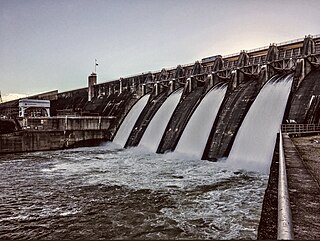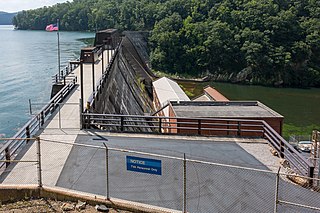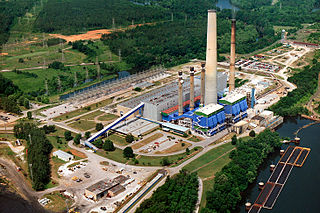
The Tennessee Valley Authority (TVA) is a federally owned electric utility corporation in the United States. TVA's service area covers all of Tennessee, portions of Alabama, Mississippi, and Kentucky, and small areas of Georgia, North Carolina, and Virginia. While owned by the federal government, TVA receives no taxpayer funding and operates similarly to a private for-profit company. It is headquartered in Knoxville, Tennessee, and is the sixth-largest power supplier and largest public utility in the country.

The Browns Ferry Nuclear Power Plant is located on the Tennessee River near Decatur and Athens, Alabama, on the north side of Wheeler Lake. The site has three General Electric boiling water reactor (BWR) nuclear generating units and is owned entirely by the Tennessee Valley Authority (TVA). With a generating capacity of nearly 3.8 gigawatts, it is the third most powerful nuclear power plant in the United States, behind the Palo Verde Nuclear Power Plant in Arizona and the Vogtle Nuclear Power Plant in Georgia, and the most powerful generating station operated by TVA.

The Sequoyah Nuclear Plant is a nuclear power plant located on 525 acres (212 ha) located 7 miles (11 km) east of Soddy-Daisy, Tennessee, and 20 miles (32 km) north of Chattanooga, abutting Chickamauga Lake on the Tennessee River. The facility is owned and operated by the Tennessee Valley Authority (TVA).

The Watts Bar Nuclear Plant is a Tennessee Valley Authority (TVA) nuclear reactor pair used for electric power generation. It is located on a 1,770-acre (7.2 km²) site in Rhea County, Tennessee, near Spring City, between Chattanooga and Knoxville. Watts Bar supplies enough electricity for about 1.2 million households in the Tennessee Valley.

The Bellefonte Nuclear Generating Station (BLN) is an unfinished nuclear power plant in Hollywood, Alabama, United States.

Watts Bar Dam is a hydroelectric dam on the Tennessee River in Meigs and Rhea counties in Tennessee, United States. The dam is one of nine dams on the main Tennessee River channel operated by the Tennessee Valley Authority, which built the dam in the early 1940s to provide flood control and electricity and to help create a continuous navigable channel along the entire length of the river. The dam is the technical boundary between the 39,090-acre (15,820 ha) Watts Bar Lake— which it impounds— and Chickamauga Lake, which stretches from the dam's tailwaters southward to Chattanooga.

Fort Loudoun Dam is a hydroelectric dam on the Tennessee River in Loudon County, Tennessee, in the southeastern United States. The dam is operated by the Tennessee Valley Authority (TVA), which built the dam in the early 1940s as part of a unified plan to provide electricity and flood control in the Tennessee Valley and create a continuous 652-mile (1,049 km) navigable river channel from Knoxville, Tennessee to Paducah, Kentucky. It is the uppermost of nine TVA dams on the Tennessee River.

The Chickamauga Dam is a hydroelectric dam on the Tennessee River in Chattanooga, Tennessee, United States. The dam is owned and operated by the Tennessee Valley Authority, which built the dam in the late 1930s as part of a New Deal era initiative to improve navigation and bring flood control and economic development to the Tennessee Valley. The dam impounds the 36,240-acre (14,670 ha) Chickamauga Lake and feeds into Nickajack Lake. The dam and associated infrastructure were listed on the National Register of Historic Places in 2017.

Kingston Fossil Plant, commonly known as Kingston Steam Plant, is a 1.4-gigawatt coal-fired power plant located in Roane County, just outside Kingston, Tennessee, on the shore of Watts Bar Lake. It is operated by the Tennessee Valley Authority. The plant is known for the Kingston Fossil Plant fly ash spill which occurred in December 2008.

Bull Run Fossil Plant, commonly known as Bull Run Steam Plant, is a retired 889 megawatt (MW), coal-fired electric generating station owned and operated by the Tennessee Valley Authority (TVA). The plant is the only coal fired power plant ever constructed by TVA with one unit, and was retired on December 1, 2023.

Cherokee Dam is a hydroelectric dam located on the Holston River in Grainger County and Jefferson County, Tennessee, in the southeastern United States. The dam is operated and maintained by the Tennessee Valley Authority, which built the dam in the early 1940s to help meet urgent demands for energy at the outbreak of World War II. Cherokee Dam is 175 feet (53 m) high and impounds the 28,780-acre (11,650 ha) Cherokee Lake. It has a generating capacity of 136 megawatts. The dam was named for the Cherokee, a Native American tribe that controlled much of East Tennessee when the first European settlers arrived in the mid-18th century.

Ocoee Dam Number 1 is a hydroelectric dam on the Ocoee River in Polk County in the U.S. state of Tennessee. The dam impounds the 1,930-acre (780 ha) Parksville Reservoir and is the farthest downstream of four dams on the Toccoa/Ocoee River owned and operated by the Tennessee Valley Authority. Completed in 1911, Ocoee No. 1 was one of the first hydroelectric projects in Tennessee.

The Hartsville Nuclear Plant is a canceled nuclear power plant project located near Hartsville, Tennessee. To be built and operated by the Tennessee Valley Authority (TVA), it was to have four General Electric boiling water reactors.

The U.S. state of Tennessee contains a diverse economy that is made up of many sectors with a mix of industries including manufacturing, agriculture, healthcare, and tourism. The state is home to several major corporations, including FedEx, the largest courier company in the world, and AutoZone, the largest retailer of auto parts in the United States.

The Paradise Combined Cycle Plant is a natural gas power plant operated by the Tennessee Valley Authority (TVA). Located just east of Drakesboro, Kentucky, it was the highest power capacity power plant in Kentucky. The plant originally consisted of three coal units, with a combined capacity of 2,632 MW. Units 1 and 2 were retired in 2017, and replaced with the natural gas units, and Unit 3 was retired in 2020. The combined cycle natural gas plant had a capacity of 1.02-gigawatts as of 2017.

Phipps Bend Nuclear Plant was a planned nuclear power generation facility that was to be constructed and operated by the Tennessee Valley Authority (TVA) in unincorporated Hawkins County, Tennessee. Proposed to house two reactor units, the power plant was estimated to cost $1.6 billion when it was first planned in late 1977, provide a generating capacity of 2,600,000 kilowatts. Following negative public reactions towards nuclear energy following the Three Mile Island accident and a decreasing demand for power due to regional economic decline, the TVA's board of directors voted to defer further construction of the power plant. By 1981, the plant was 40% complete and an estimated $1.5 billion in planning, engineering, and construction costs had accumulated. Construction never resumed, and the project was canceled overall in 1982 due to lower load growth than forecast. By the project's cancellation, the TVA had amassed over $2.6 billion in spending for the incomplete nuclear facility. After being auctioned off by the TVA in 1987, the land acquired for the plant would be under the ownership of Hawkins County's industrial development board, who converted most of the site into an industrial park. A 1 MW solar farm was built at the site in 2017.

The Gallatin Fossil Plant is a coal and natural gas-fired power plant near Gallatin, Tennessee operated by the Tennessee Valley Authority (TVA). The plant was originally entirely a coal-fired plant, constructed in the 1950s, and natural gas units were added later.

The Colbert Combustion Turbine Plant is a combustion turbine natural gas-fired power plant operated by the Tennessee Valley Authority (TVA) near Tuscumbia, Alabama. Commissioned in 1972, it is currently the oldest gas-fired power plant operated by TVA. The site was formerly home to the Colbert Fossil Plant, a coal-fired power station which operated from 1955 to 2016.



















